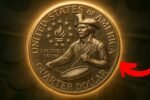2013 $100 Bill : In the world of paper currency collecting, sometimes the most valuable items are hiding in plain sight. One such bill — the 2013 $100 note — may look ordinary at first glance, but certain versions of it are now considered rare and can fetch significant value in the collector’s market.
If you’ve got an old $100 tucked in your wallet or savings jar, it might be time to give it a closer look.
Why the 2013 Series $100 Bill Is Getting Attention
The 2013 series of the $100 bill features the modern “blue ribbon” security design introduced to prevent counterfeiting. While millions were printed and circulated, only a small portion have the rare characteristics that can turn this bill from a simple hundred into a valuable collectible.
What sets some of these 2013 notes apart are specific serial number patterns, printing errors, or other unique traits that appeal to collectors. And yes — some of these notes have already been sold for thousands of dollars in auctions and private sales.
The Serial Numbers That Matter
Collectors have long placed a premium on “fancy” serial numbers, and the 2013 $100 bill is no exception. Here’s what to look for:
- Repeater serial numbers: These have a repeating pattern, such as 29292929 or 12341234.
- Radar notes: Read the same forward and backward, like 12344321 or 80000008.
- Low serial numbers: Anything like 00000001 to 00000100 can be highly desirable.
- Solid numbers: Such as 11111111 or 99999999.
- Star notes: Bills that have a star symbol at the end of the serial number instead of a letter. These replace misprinted notes and are printed in much smaller quantities.
A 2013 $100 bill with a rare serial number can be worth many times its face value — especially if it is uncirculated or in pristine condition.
Printing Errors That Raise Value
Errors make certain notes extremely collectible. The U.S. Bureau of Engraving and Printing occasionally makes mistakes, and these flawed bills sometimes escape into circulation.
Valuable 2013 $100 errors include:
- Ink smears or misalignment
- Shifted security features
- Missing or doubled print
- Incorrect color bands or seals
Even slight anomalies can increase a bill’s value dramatically, depending on the rarity and visual uniqueness of the mistake.
Condition Is Key
Even if you have a 2013 $100 bill with a rare serial number or printing error, condition will heavily influence the value. Collectors look for:
- Crisp, uncirculated paper
- Sharp corners
- No folds, tears, or stains
- Clear and centered print
If your bill checks all the boxes, consider having it professionally graded by a currency grading service such as PCGS or PMG. Certified grades can help increase the selling price significantly.
How Much Are Rare 2013 $100 Bills Worth?
Some examples of rare 2013 $100 bills have sold for over $2,000 to $15,000, depending on their rarity, condition, and demand. Star notes with fancy serials in gem condition have drawn bids far above face value at online auctions and collector marketplaces.
It’s not just about rarity — it’s also about timing, demand, and finding the right buyer.
Where to Check Your Bills
If you’re now rushing to check your wallet or cash drawer, here’s how to spot the clues:
- Look at the serial number — is it unusual or patterned?
- Is there a star at the end of the serial?
- Are there any visible misprints or alignment errors?
- How’s the overall condition?
Websites like MyCurrencyCollection.com or PaperMoneyGuide.com let you compare your bills and track current collector demand.
Should You Hold or Sell?
If you find a rare 2013 $100 bill, your next move depends on your goals. Holding onto it might yield higher returns as collectors’ interest grows. On the other hand, the current market for fancy serials and errors is active, and sellers are often getting premium prices now.
You can sell through:
- Online auction platforms like eBay
- Collector forums and marketplaces
- Currency dealers
- Coin and currency shows
Final Thoughts
The next time someone hands you a $100 bill from 2013, take a second before stuffing it into your wallet. You might just be holding a piece of modern currency history — and a surprising source of hidden value. With just a little attention to detail, you could turn an everyday bill into a collector’s treasure.





